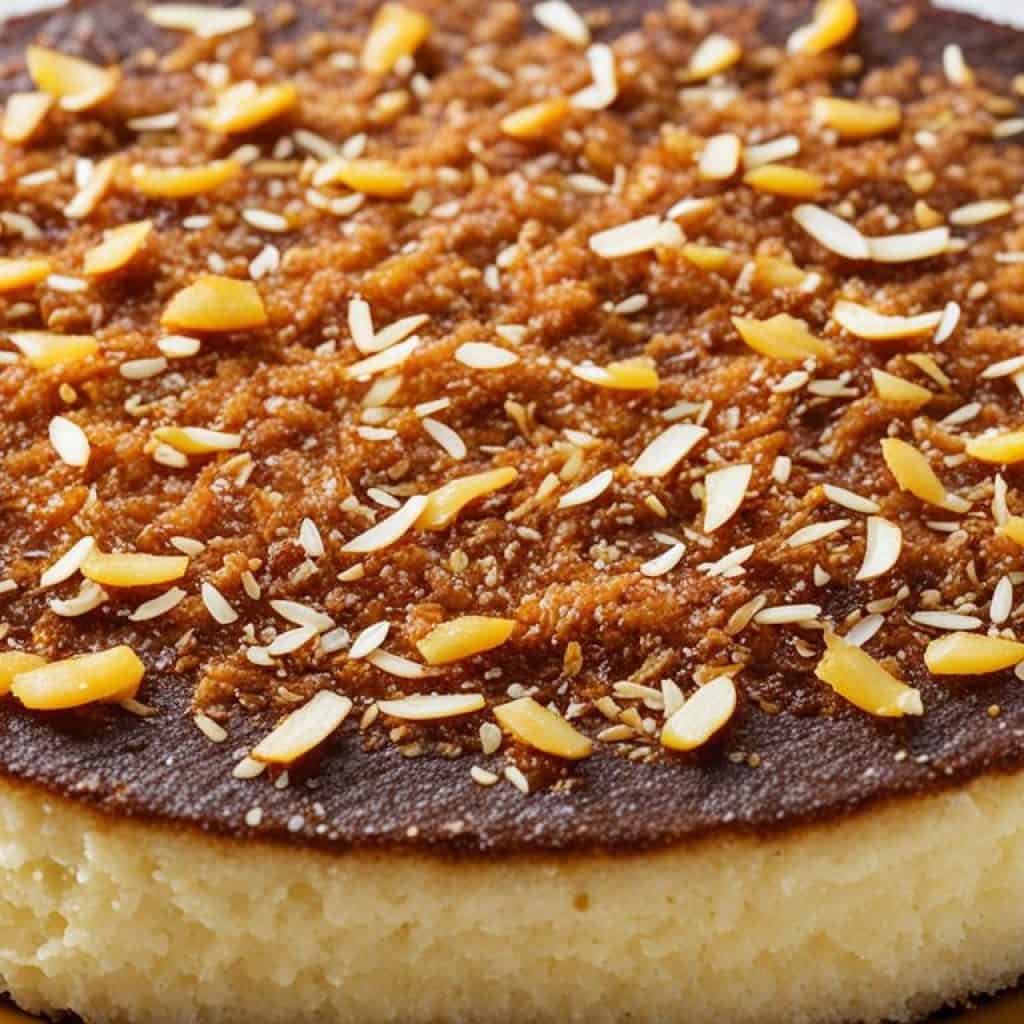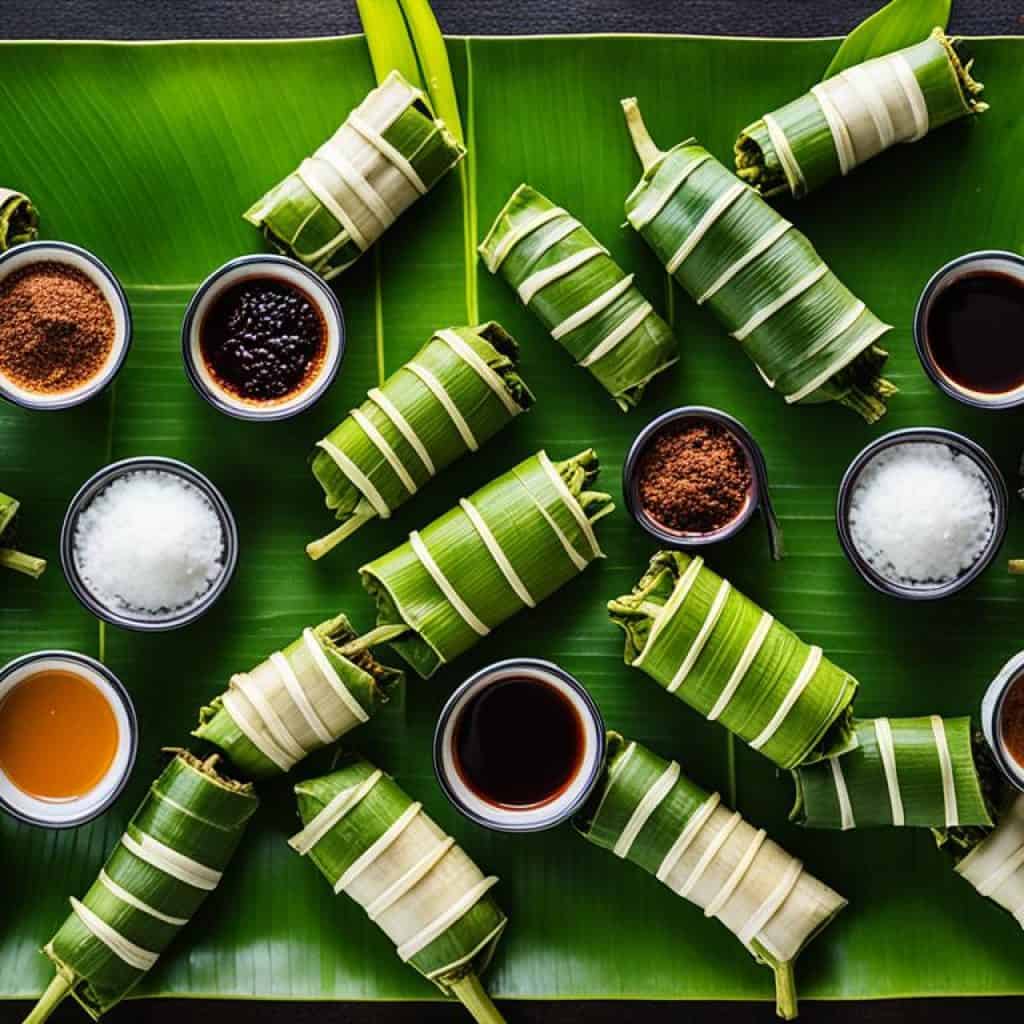When it comes to Filipino delicacies, there is one sweet treat that stands out for its incredible variety and rich flavors. From colorful rice cakes to mouthwatering desserts, kakanin offers a delectable journey through traditional Filipino sweets. But what makes kakanin in the Philippines so unique? And why is it such a beloved part of Filipino culture?
Key Takeaways:
- Kakanin is a diverse collection of traditional Filipino sweets made from glutinous rice and coconut milk.
- These delightful rice cakes are deeply rooted in Filipino culture and are often enjoyed during special occasions and celebrations.
- With a wide range of flavors, colors, and textures, kakanin offers a delicious tapestry of flavors for everyone to savor.
- Exploring the world of kakanin is a delightful way to experience the rich culinary heritage of the Philippines.
- Be prepared to indulge in an array of unique and delicious Filipino delicacies that are sure to satisfy your sweet tooth.
What is Kakanin?
Kakanin is a term derived from the Tagalog words “kain” (to eat) and “kanin” (rice). It refers to a wide range of Filipino sweets made from glutinous rice and coconut milk. There are two main types of kakanin preparations: those made with galapong, which is rice flour soaked, ground, and strained, and those made with malagkit, or sticky rice grains that are either ground or left whole. These ingredients are used to create a variety of textures and flavors in different kakanin recipes.
“Kakanin is not just a delicious indulgence, but it also embodies the rich culinary heritage and traditions of the Philippines. It is a celebration of the vibrant flavors and textures that can be achieved with simple ingredients like glutinous rice and coconut milk.”
– Chef Maria Santos
Biko – A Classic Delight
Biko is a popular kakanin made with malagkit rice and coconut milk. It is traditionally served at town fiestas, weddings, and funerals. This sticky rice cake has a dark brown topping and a gooey, sticky texture with a nutty sweetness. The name “biko” comes from the coffee-colored, sweet coconut curd that gives it its distinctive flavor. Biko is also sometimes referred to as kalamay, although strictly speaking, kalamay is a separate component made from coconut milk, brown sugar, and glutinous rice powder.

The Flavors of Biko
Biko delights the taste buds with its unique combination of flavors. The rich and creamy coconut milk infuses the sticky rice grains, creating a luscious texture. The dark brown topping, made from caramelized coconut curd, adds a hint of sweetness and depth of flavor. Together, these elements come together to create a harmonious and indulgent dessert that is sure to satisfy any sweet tooth.
“Biko takes me back to my childhood, where I would eagerly wait for special occasions just to enjoy a slice of this delicious rice cake. The sticky and sweet flavors, combined with the chewy texture, create a truly nostalgic experience.” – Maria, avid biko lover
Tradition and Celebration
Biko holds a special place in Filipino culture, often being served during significant celebrations and gatherings. Its presence at town fiestas, weddings, and funerals is a testament to its versatility and symbolic importance. Sharing a plate of biko with friends and family not only brings people together but also represents the unity and warmth of Filipino hospitality.
Recipe
If you want to experience the delight of homemade biko, here’s a simple recipe to try:
| Ingredients | Instructions |
|---|---|
|
|
Now that you know the secrets behind this classic Filipino delicacy, it’s time to indulge in the sticky goodness of biko. Whether it’s a special occasion or a simple craving, this traditional rice cake is guaranteed to bring joy to every bite.
Puto – The All-Time Favorite
In the realm of Filipino delicacies, one treat reigns supreme – the delectable puto. This steamed rice cake has stolen the hearts and taste buds of Filipinos across the nation, making it the all-time favorite kakanin in the Philippines.
Puto is a fluffy and moist rice cake that is traditionally white in color. However, it’s not constrained by tradition alone, as it can also be flavored with pandan or ube, lending it a vibrant green or purple hue. With its versatile nature, puto can adapt to various flavors and preferences, making it a truly versatile Filipino delicacy.
One of the best things about puto is its ability to complement savory dishes. Oftentimes, you’ll find puto served alongside rich stews or barbecued meats, forming a delicious balance of flavors. It serves as a delightful accompaniment, adding a touch of sweetness to the meal.
What’s truly fascinating about puto is its small, bite-sized nature. The name itself, “puto,” is derived from the Malay word “puttu,” which means “portioned.” The diminutive size of these steamed rice cakes allows for easy consumption and adds to their charm. They are perfect for snacking, sharing with friends and family, or even enjoying on their own.
To enhance the taste and texture of puto, it can be topped with a variety of ingredients. Common options include cheese, which adds a savory and creamy element, or salted egg, which lends a delightful contrast in flavors. The toppings not only enhance the taste but also add visual appeal to these already enticing treats.
“Puto is a versatile Filipino delicacy that brings joy to every occasion. Whether you savor it on its own or pair it with savory viands, the delightful combination of its soft texture, delicate flavor, and petite size will surely leave you wanting more.”
Indulging in puto is like taking a bite out of Filipino culture. Its irresistible taste and cultural significance make it a staple at celebrations, festivals, and family gatherings. From the warm aroma that fills the air when puto is freshly steamed to the satisfaction of savoring it bite by bite, this Filipino delicacy holds a special place in the hearts of many.
When it comes to Filipino delicacies, few can match the popularity and appeal of puto. Its simple yet exquisite flavor, coupled with its charming presentation, makes it a perennial favorite. Whether you’re a resident of the Philippines or a curious traveler, make sure to indulge in the magic of puto and discover the captivating taste of this beloved steamed rice cake.
Sapin-sapin – A Festive Delight
Sapin-sapin is a festive and colorful kakanin made with glutinous rice flour, coconut milk, sugar, condensed milk, and various flavorings such as ube, langka, or cheese. It is known for its dense, pudding-like texture and is often seen at social gatherings and special occasions.
The name “sapin-sapin” means “layers,” which refers to the kakanin’s appearance and preparation method. Each layer of the glutinous rice batter is steamed and set before the next layer is poured, resulting in vibrant colors and distinct flavors.
This Filipino layered dessert is as visually appealing as it is delicious. The combination of flavors and textures in each bite is truly a treat for the senses. The softness of the glutinous rice, the creaminess of the coconut milk, and the sweetness of the various flavorings create a harmonious blend that is simply irresistible.
Whether enjoyed as a midday snack or served as a finale to a festive feast, sapin-sapin never fails to delight. Its vibrant colors and delightful taste make it a standout among traditional Filipino desserts.

| Ingredients | Instructions |
|---|---|
| 1 cup glutinous rice flour |
|
Whether you’re celebrating a special occasion or simply indulging in a sweet treat, sapin-sapin is a Filipino dessert that is sure to impress. Its beautiful layers and delightful combination of flavors make it a true festive delight.
Ginataang Bilo-Bilo – Comfort in a Bowl
If you’re looking for a comforting and satisfying Filipino dessert, look no further than Ginataang Bilo-Bilo. This delicious kakanin is a warm and hearty bowl of goodness that combines diced root vegetables, sweet bananas, and chewy rice balls, all cooked together in a soupy gruel thickened with creamy coconut milk. It’s the perfect treat to warm your soul on a chilly day or to enjoy as a comforting dessert any time.
Ginataang Bilo-Bilo gets its name from the term “ginataan,” which means “cooked with coconut milk,” and “bilo-bilo,” which refers to the rice balls that resemble small marbles. This delightful dessert is a popular choice among Filipinos, especially during special occasions and festive gatherings.
What sets Ginataang Bilo-Bilo apart are the root vegetables that add a delicious and nutritious twist to the dish. Commonly used root vegetables include kamote (sweet potato) and ube (purple yam), which lend their earthy flavors and vibrant colors to the dessert. The sweet bananas provide a pleasant contrast to the creamy coconut milk, while the chewy rice balls add a delightful textural element to each spoonful.
The combination of flavors and textures in Ginataang Bilo-Bilo creates a harmonious blend that will leave you craving for more. The mild sweetness from the coconut milk and the natural sweetness of the root vegetables and bananas make every spoonful a delightful experience.
Whether you’re looking for a comforting dessert or want to explore the rich flavors of Filipino kakanin, Ginataang Bilo-Bilo is a must-try. Its warm and comforting nature, combined with the unique flavors of root vegetables and chewy rice balls, make it a true comfort in a bowl. So, grab a spoon and indulge in this delicious and satisfying Filipino treat!
Suman – The Quintessential Rice Cake
Suman is a quintessential Filipino rice cake that holds a special place in the hearts and taste buds of Filipinos. Made from glutinous rice, coconut milk, and sugar, suman is a simple yet delectable delicacy that is beloved by many.
This traditional Filipino rice cake is wrapped tightly in palm leaves, giving it a distinct aroma and flavor. The leaves help to retain moisture and infuse the suman with a subtle earthy essence. Once wrapped, the suman is steamed to perfection, resulting in a sticky and chewy texture that is irresistible.
One of the beauty of suman is its versatility. It can be enjoyed on its own, where the mild sweetness of the glutinous rice and the creaminess of the coconut milk take center stage. For a touch of indulgence, suman can be paired with a sprinkling of sugar, further enhancing its natural flavors. For those looking for a richer experience, frying the suman adds a delightful crispiness to the exterior while keeping the inside soft and tender. And for the ultimate treat, suman can be served alongside ripe mangoes and a scoop of macapuno ice cream, creating a heavenly combination of sweet, tangy, and creamy flavors.

Suman has a long and storied history in the Philippines. Its origins date back to the pre-colonial era, where it was already a popular staple among the indigenous communities. When the Spanish arrived in the 16th century, they documented the presence of suman in their accounts. Antonio Pigafetta, the chronicler of the first Spanish expedition to the Philippines, described suman as “rice cakes wrapped in leaves, with somewhat longish pieces.” The name “suman” itself is believed to have been lost to history, but its enduring presence in Filipino cuisine speaks volumes about its cultural significance.
Whether enjoyed during special occasions or as an everyday treat, suman brings joy and comfort to those who indulge in its simple yet delightful flavors. Its humble ingredients and traditional preparation method reflect the essence of Filipino culinary heritage and the warmth of Filipino hospitality. Savoring a piece of suman is not just a culinary experience; it’s an opportunity to connect with the rich history and cultural traditions of the Philippines.
Kutsinta – Unique and Delicious
Indulge in the unique and delicious flavors of Kutsinta, a beloved Filipino rice cake that is sure to satisfy your sweet tooth. Made from a combination of rice flour, brown sugar, and lye water, Kutsinta stands out with its distinct muddy yellow color and jelly-like texture that melts in your mouth. This delightful delicacy is a popular choice among locals and visitors alike.
The process of making Kutsinta involves combining the ingredients to create a smooth batter that is poured into individual molds. These molds are then steamed until the Kutsinta is cooked to perfection. The addition of lye water gives the Kutsinta its signature texture and adds a unique depth of flavor, making it a truly one-of-a-kind treat.
When it comes to serving Kutsinta, grated coconut is a traditional accompaniment that adds a touch of freshness and complements the sweetness of the cake. The combination of the soft, jelly-like Kutsinta and the slightly crunchy coconut creates a delightful contrast of textures.
Kutsinta is often sold in packs alongside other Filipino rice cakes like Puto, making it a convenient choice for those who want to try a variety of kakanin. Whether enjoyed as a snack or as part of a larger meal, Kutsinta never fails to impress with its unique taste and texture.
To give you a visual representation of what to expect from Kutsinta, take a look at the image below:
Ingredients:
- Rice flour
- Brown sugar
- Lye water
- Grated coconut (for serving)
Instructions:
- In a mixing bowl, combine the rice flour, brown sugar, and lye water. Mix well until the sugar is dissolved.
- Fill individual Kutsinta molds with the batter, leaving some space at the top for the Kutsinta to expand.
- Place the molds in a steamer and steam over medium heat for about 20-25 minutes or until the Kutsinta is firm and set.
- Remove the Kutsinta from the molds and let them cool.
- Serve the Kutsinta with grated coconut on top and enjoy!
Summary:
Kutsinta is a unique and delicious Filipino rice cake made with rice flour, brown sugar, and lye water. Its distinct color, jelly-like texture, and exquisite flavor make it a favorite among locals and visitors alike. Served with grated coconut, Kutsinta is a delightful treat that showcases the rich culinary heritage of the Philippines.
Palitaw – Soft and Chewy Delight
Indulge in the delightful simplicity of Palitaw, a traditional Filipino rice cake that offers a soft and chewy texture. Made from a mixture of glutinous rice flour, water, and sugar, Palitaw is a beloved kakanin enjoyed by many. The process of creating these delectable treats involves forming small balls from the dough, flattening them, and then boiling them until they become tender.
Once cooked, Palitaw is traditionally served with grated coconut and sesame seeds. The grated coconut adds a subtle sweetness and enhances the overall flavor, while the sesame seeds provide a pleasant nutty crunch. This combination of flavors and textures makes Palitaw a truly satisfying dessert that embodies the essence of Filipino cuisine.
Palitaw – The Name and Cultural Significance
The name “Palitaw” holds significance as it refers to the cooking process itself. When these rice cakes are boiled, they rise to the surface of the pot, indicating that they are perfectly cooked and ready to be served. This unique characteristic has led to the colloquial name “dila-dila,” which means “tongue-like,” describing the broad and flat shape of the rice cakes.
Palitaw – A Taste of Filipino Heritage
Palitaw not only satisfies the palate but also carries with it a rich cultural heritage. This humble kakanin represents the ingenuity and resourcefulness of Filipino cuisine, utilizing simple ingredients to create a delightful dessert. Its soft and chewy texture, combined with the subtle sweetness of grated coconut, makes every bite of Palitaw a truly enjoyable experience.
| Ingredients | Description |
|---|---|
| Glutinous Rice Flour | The main ingredient that gives Palitaw its distinct chewiness. |
| Water | Used to form the dough and boil the rice cakes until tender. |
| Sugar | Provides a subtle sweetness to the rice cakes. |
| Grated Coconut | Traditionally served as a topping to enhance the flavor. |
| Sesame Seeds | Adds a delightful crunch to each bite. |
Whether enjoyed as a snack or as a dessert, Palitaw offers a unique culinary experience that truly represents the flavors and traditions of Filipino cuisine. Its soft and chewy texture, combined with the delightful interplay of coconut and sesame, is sure to leave you craving for more.
Conclusion
Filipino delicacies are a true testament to the rich culinary heritage of the Philippines. The traditional Filipino sweets, known as kakanin, offer a delightful array of flavors and textures that are deeply rooted in the country’s culture. From the classic biko to the all-time favorite puto, and the colorful sapin-sapin to the comforting ginataang bilo-bilo, each kakanin showcases the unique taste and cultural significance of indigenous Filipino pastries.
These sweet Filipino treats are not only enjoyed on special occasions but also make for a delightful snack any time of the day. The combination of glutinous rice, coconut milk, and local ingredients create a diverse and mouthwatering experience for both locals and visitors. Exploring the world of kakanin is a rewarding journey in discovering the true flavors of the Philippines.
So whether you’re indulging in the nutty sweetness of biko or savoring the soft and chewy delight of palitaw, the world of kakanin invites you to savor the variety of these traditional Filipino sweets. Immerse yourself in the rich and diverse culinary heritage of the Philippines and experience the authentic taste of these beloved indigenous Filipino pastries. Don’t miss out on the opportunity to treat yourself to the sweet flavors of Filipino delicacies.


















Add comment